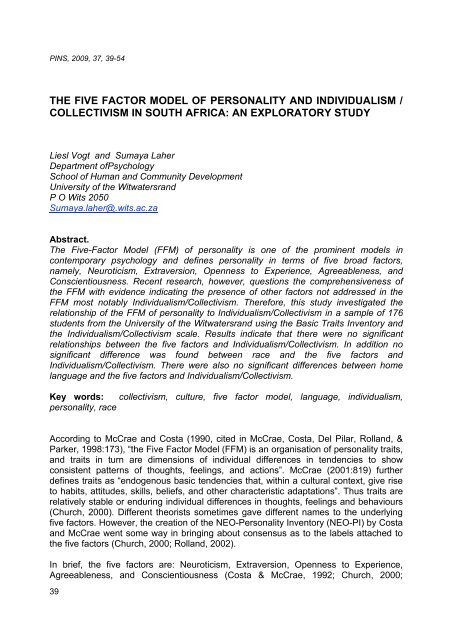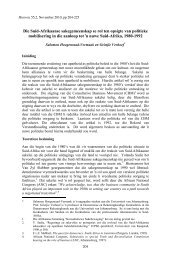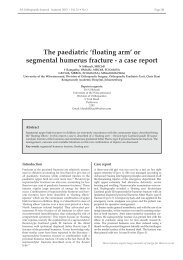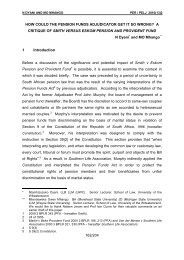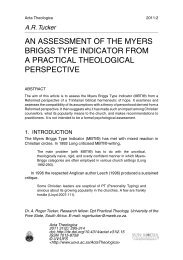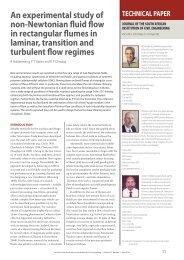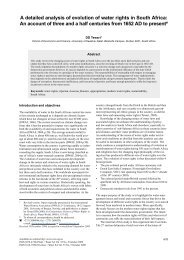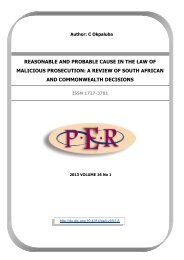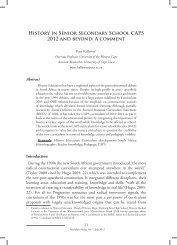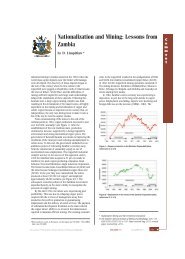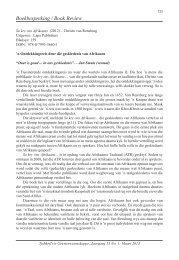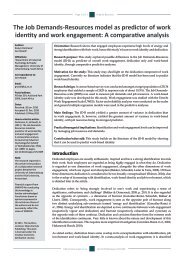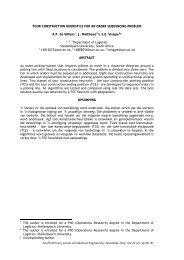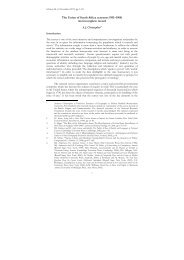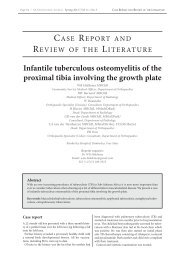the five factor model of personality and individualism / collectivism in ...
the five factor model of personality and individualism / collectivism in ...
the five factor model of personality and individualism / collectivism in ...
Create successful ePaper yourself
Turn your PDF publications into a flip-book with our unique Google optimized e-Paper software.
PINS, 2009, 37, 39-54<br />
THE FIVE FACTOR MODEL OF PERSONALITY AND INDIVIDUALISM /<br />
COLLECTIVISM IN SOUTH AFRICA: AN EXPLORATORY STUDY<br />
Liesl Vogt <strong>and</strong> Sumaya Laher<br />
Department <strong>of</strong>Psychology<br />
School <strong>of</strong> Human <strong>and</strong> Community Development<br />
University <strong>of</strong> <strong>the</strong> Witwatersr<strong>and</strong><br />
P O Wits 2050<br />
Sumaya.laher@.wits.ac.za<br />
Abstract.<br />
The Five-Factor Model (FFM) <strong>of</strong> <strong>personality</strong> is one <strong>of</strong> <strong>the</strong> prom<strong>in</strong>ent <strong>model</strong>s <strong>in</strong><br />
contemporary psychology <strong>and</strong> def<strong>in</strong>es <strong>personality</strong> <strong>in</strong> terms <strong>of</strong> <strong>five</strong> broad <strong>factor</strong>s,<br />
namely, Neuroticism, Extraversion, Openness to Experience, Agreeableness, <strong>and</strong><br />
Conscientiousness. Recent research, however, questions <strong>the</strong> comprehensiveness <strong>of</strong><br />
<strong>the</strong> FFM with evidence <strong>in</strong>dicat<strong>in</strong>g <strong>the</strong> presence <strong>of</strong> o<strong>the</strong>r <strong>factor</strong>s not addressed <strong>in</strong> <strong>the</strong><br />
FFM most notably Individualism/Collectivism. Therefore, this study <strong>in</strong>vestigated <strong>the</strong><br />
relationship <strong>of</strong> <strong>the</strong> FFM <strong>of</strong> <strong>personality</strong> to Individualism/Collectivism <strong>in</strong> a sample <strong>of</strong> 176<br />
students from <strong>the</strong> University <strong>of</strong> <strong>the</strong> Witwatersr<strong>and</strong> us<strong>in</strong>g <strong>the</strong> Basic Traits Inventory <strong>and</strong><br />
<strong>the</strong> Individualism/Collectivism scale. Results <strong>in</strong>dicate that <strong>the</strong>re were no significant<br />
relationships between <strong>the</strong> <strong>five</strong> <strong>factor</strong>s <strong>and</strong> Individualism/Collectivism. In addition no<br />
significant difference was found between race <strong>and</strong> <strong>the</strong> <strong>five</strong> <strong>factor</strong>s <strong>and</strong><br />
Individualism/Collectivism. There were also no significant differences between home<br />
language <strong>and</strong> <strong>the</strong> <strong>five</strong> <strong>factor</strong>s <strong>and</strong> Individualism/Collectivism.<br />
Key words: <strong>collectivism</strong>, culture, <strong>five</strong> <strong>factor</strong> <strong>model</strong>, language, <strong><strong>in</strong>dividualism</strong>,<br />
<strong>personality</strong>, race<br />
Accord<strong>in</strong>g to McCrae <strong>and</strong> Costa (1990, cited <strong>in</strong> McCrae, Costa, Del Pilar, Roll<strong>and</strong>, &<br />
Parker, 1998:173), “<strong>the</strong> Five Factor Model (FFM) is an organisation <strong>of</strong> <strong>personality</strong> traits,<br />
<strong>and</strong> traits <strong>in</strong> turn are dimensions <strong>of</strong> <strong>in</strong>dividual differences <strong>in</strong> tendencies to show<br />
consistent patterns <strong>of</strong> thoughts, feel<strong>in</strong>gs, <strong>and</strong> actions”. McCrae (2001:819) fur<strong>the</strong>r<br />
def<strong>in</strong>es traits as “endogenous basic tendencies that, with<strong>in</strong> a cultural context, give rise<br />
to habits, attitudes, skills, beliefs, <strong>and</strong> o<strong>the</strong>r characteristic adaptations”. Thus traits are<br />
relatively stable or endur<strong>in</strong>g <strong>in</strong>dividual differences <strong>in</strong> thoughts, feel<strong>in</strong>gs <strong>and</strong> behaviours<br />
(Church, 2000). Different <strong>the</strong>orists sometimes gave different names to <strong>the</strong> underly<strong>in</strong>g<br />
<strong>five</strong> <strong>factor</strong>s. However, <strong>the</strong> creation <strong>of</strong> <strong>the</strong> NEO-Personality Inventory (NEO-PI) by Costa<br />
<strong>and</strong> McCrae went some way <strong>in</strong> br<strong>in</strong>g<strong>in</strong>g about consensus as to <strong>the</strong> labels attached to<br />
<strong>the</strong> <strong>five</strong> <strong>factor</strong>s (Church, 2000; Roll<strong>and</strong>, 2002).<br />
In brief, <strong>the</strong> <strong>five</strong> <strong>factor</strong>s are: Neuroticism, Extraversion, Openness to Experience,<br />
Agreeableness, <strong>and</strong> Conscientiousness (Costa & McCrae, 1992; Church, 2000;<br />
39
Roll<strong>and</strong>, 2002). Neuroticism is def<strong>in</strong>ed as a general tendency to experience negative<br />
affects such as fear, sadness, embarrassment, anger, guilt, <strong>and</strong> distrust. It is <strong>the</strong><br />
degree to which a person is calm <strong>and</strong> self-confident as opposed to anxious <strong>and</strong><br />
<strong>in</strong>secure. Extraversion is regarded as a general tendency toward sociability,<br />
assertiveness, activeness <strong>and</strong> be<strong>in</strong>g talkative. Thus it is <strong>the</strong> degree to which a person is<br />
sociable, leaderlike <strong>and</strong> assertive as opposed to withdrawn, quiet <strong>and</strong> reserved.<br />
Individuals will<strong>in</strong>g to enterta<strong>in</strong> novel ideas <strong>and</strong> unconventional values are described by<br />
<strong>the</strong> openness to experience trait. Openness to Experience is def<strong>in</strong>ed as <strong>the</strong> degree to<br />
which a person is imag<strong>in</strong>ative <strong>and</strong> curious as opposed to concrete m<strong>in</strong>ded <strong>and</strong> narrow<br />
th<strong>in</strong>k<strong>in</strong>g. Agreeableness encapsulates constructs <strong>of</strong> sympathy, co-operativeness, <strong>and</strong><br />
helpfulness towards o<strong>the</strong>rs. It is described as <strong>the</strong> degree to which a person is good<br />
natured, warm <strong>and</strong> co-operative as opposed to irritable, uncooperative, <strong>in</strong>flexible,<br />
unpleasant <strong>and</strong> disagreeable. The f<strong>in</strong>al <strong>factor</strong>, Conscientiousness, may be described<br />
as <strong>the</strong> degree to which a person is persever<strong>in</strong>g, responsible <strong>and</strong> organised as opposed<br />
to lazy, irresponsible, <strong>and</strong> impulsive. This dimension summarizes <strong>the</strong> more specific<br />
traits that mark careful, responsible <strong>and</strong> dependable people <strong>in</strong> contrast to people who<br />
are lazy <strong>and</strong> lack self-discipl<strong>in</strong>e (Costa & McCrae, 1992; McCrae, et al, 1998; Roll<strong>and</strong>,<br />
2002).<br />
An exam<strong>in</strong>ation <strong>of</strong> research suggests <strong>the</strong> universality <strong>of</strong> <strong>the</strong> FFM (Allik & McCrae, 2004;<br />
McCrae & Terracciano, 2005), but evidence also exists that suggests that <strong>the</strong> FFM is<br />
not comprehensive <strong>in</strong> its description <strong>of</strong> <strong>personality</strong> (see Church, 2000; Cheung, Leung,<br />
Zhang, Sun, Gan & Song, 2001; Katigbak, Church, Guanzon-Lapena, Carlota & Del<br />
Pilar, 2002; Piedmont, Ba<strong>in</strong>, McCrae & Costa, 2002; Cheung, 2004; Teferi, 2004;<br />
Ashton & Lee, 2005; McCrae & Terraccianno, 2005; Saucier & Skrzyp<strong>in</strong>ska, 2006).<br />
Fur<strong>the</strong>rmore studies on <strong>the</strong> NEO-PI-R <strong>in</strong> cross-cultural situations found variations <strong>in</strong> <strong>the</strong><br />
<strong>five</strong> <strong>factor</strong> structure between Western <strong>and</strong> Asian cultures (see Church, 2000; Cheung,<br />
et al, 2001; Cheung, 2004; McCrae & Terraccianno, 2005). McCrae (2004) <strong>in</strong>terpreted<br />
this as <strong>the</strong> likely consequence <strong>of</strong> <strong>the</strong> differences between <strong>the</strong> <strong>in</strong>dividualistic societies <strong>of</strong><br />
<strong>the</strong> West <strong>and</strong> <strong>the</strong> collectivist societies <strong>of</strong> Asia (Roll<strong>and</strong>, Parker & Stumpf, 1998;<br />
McCrae, 2004).<br />
Research <strong>in</strong> <strong>the</strong> Ch<strong>in</strong>ese context sought to establish <strong>the</strong> universality <strong>and</strong> sufficiency <strong>of</strong><br />
<strong>the</strong> FFM. Both <strong>the</strong> NEO-PI-R <strong>and</strong> <strong>the</strong> Ch<strong>in</strong>ese Personality Assessment Inventory<br />
(CPAI), a <strong>personality</strong> <strong>in</strong>ventory developed specifically for <strong>the</strong> Ch<strong>in</strong>ese context, were<br />
used <strong>in</strong> this study. Through <strong>factor</strong> analysis a unique <strong>factor</strong> that did not have <strong>factor</strong><br />
load<strong>in</strong>gs on any <strong>of</strong> <strong>the</strong> facets <strong>of</strong> <strong>the</strong> NEO-PI-R was obta<strong>in</strong>ed from <strong>the</strong> CPAI scales. This<br />
<strong>factor</strong> has been called Interpersonal Relatedness, which emphasizes <strong>the</strong> concern <strong>of</strong><br />
<strong>in</strong>terdependence <strong>in</strong> Ch<strong>in</strong>ese <strong>personality</strong> (Cheung et al, 2001). The issue <strong>the</strong>n became<br />
whe<strong>the</strong>r <strong>the</strong> Interpersonal Relatedness <strong>factor</strong> was unique to Ch<strong>in</strong>ese societies, or<br />
whe<strong>the</strong>r <strong>in</strong> fact this doma<strong>in</strong> <strong>of</strong> <strong>personality</strong> perta<strong>in</strong>ed to o<strong>the</strong>r cultures as well. Cheung et<br />
al (2001) replicated this study on a culturally diverse group <strong>of</strong> Hawaiian students <strong>and</strong><br />
found that <strong>the</strong> Interpersonal Relatedness <strong>factor</strong> could be identified <strong>in</strong> this group.<br />
Cheung, Cheung, Leung, Ward <strong>and</strong> Leong (2003) found similar results with <strong>the</strong> English<br />
version <strong>of</strong> <strong>the</strong> CPAI. This research provided empirical support for arguments on <strong>the</strong><br />
comprehensiveness <strong>of</strong> <strong>the</strong> FFM particularly as <strong>the</strong>y perta<strong>in</strong>ed to <strong>the</strong><br />
Individualism/Collectivism dimension.<br />
40
INDIVIDUALISM AND COLLECTIVISM.<br />
Individualism <strong>and</strong> Collectivism are at present amongst <strong>the</strong> most widely used constructs<br />
<strong>in</strong> research about cultural differences (Tri<strong>and</strong>is, 2001; Oyserman, Coon &<br />
Kemmelmeier, 2002; Tri<strong>and</strong>is & Suh, 2002; Green, Deschamps & Páez, 2005;<br />
Schimmack, Oishi & Diener, 2005). These constructs, toge<strong>the</strong>r with “power-distance”,<br />
“mascul<strong>in</strong>ity-fem<strong>in</strong><strong>in</strong>ity” <strong>and</strong> “uncerta<strong>in</strong>ty- avoidance” were first described as overarch<strong>in</strong>g<br />
patterns <strong>of</strong> cultural variation <strong>in</strong> <strong>the</strong> workplace by Geert H<strong>of</strong>stede <strong>in</strong> 1980 (Earley<br />
& Gibson, 1998; Oyserman et al, 2002; Shulruf, Hattie & Dixon, 2003). Accord<strong>in</strong>g to<br />
H<strong>of</strong>stede’s <strong>model</strong>, derived through <strong>factor</strong> analysis, Individualism-Collectivism can be<br />
viewed as opposite poles represent<strong>in</strong>g an <strong>in</strong>dependent stance from groups on <strong>the</strong> one<br />
h<strong>and</strong> to a dependence on groups on <strong>the</strong> o<strong>the</strong>r (Gouveia & Ros, 2000). However,<br />
<strong><strong>in</strong>dividualism</strong> <strong>and</strong> <strong>collectivism</strong> are complex constructs which have been subject to<br />
differ<strong>in</strong>g <strong>in</strong>terpretations <strong>and</strong> hence have several different def<strong>in</strong>itions.<br />
Broadly, constructs such as <strong><strong>in</strong>dividualism</strong> <strong>and</strong> <strong>collectivism</strong> have been def<strong>in</strong>ed <strong>in</strong> terms<br />
<strong>of</strong> <strong>the</strong> attributes possessed by <strong>the</strong> people with<strong>in</strong> a given culture reflect<strong>in</strong>g ei<strong>the</strong>r position<br />
(Tri<strong>and</strong>is, McCusker & Hui, 1990). With<strong>in</strong> an <strong>in</strong>dividualist society, people are viewed as<br />
<strong>in</strong>dependent from <strong>the</strong> group. Consequently, priority is given to personal goals over<br />
those <strong>of</strong> <strong>the</strong> group <strong>and</strong> behaviour tends to be based on personal attitudes ra<strong>the</strong>r than<br />
group norms (Tri<strong>and</strong>is, 2001; Green et al, 2005). Conversely, collectivist societies<br />
emphasize people’s <strong>in</strong>terdependence with<strong>in</strong> <strong>the</strong> group, group goals are given priority<br />
<strong>and</strong> people’s behaviour is largely regulated by group norms ra<strong>the</strong>r than personal<br />
attitudes. Therefore, people <strong>in</strong> a collectivist society are ma<strong>in</strong>ly <strong>in</strong>terested <strong>in</strong> ma<strong>in</strong>ta<strong>in</strong><strong>in</strong>g<br />
relationships with o<strong>the</strong>rs <strong>and</strong> avoid<strong>in</strong>g conflict (Tri<strong>and</strong>is, 2001; Green et al, 2005).<br />
From <strong>the</strong> discussion above it is clear that Individualism/Collectivism can be viewed at<br />
both <strong>the</strong> societal <strong>and</strong> <strong>in</strong>dividual level. At <strong>the</strong> societal level, it may be argued that<br />
Individualism/Collectivism is a cultural syndrome <strong>and</strong> not necessarily a <strong>personality</strong> trait.<br />
However it is clear from <strong>the</strong> research by Cheung <strong>and</strong> colleagues that <strong>the</strong>se cultural<br />
manifestations have an <strong>in</strong>dividual basis <strong>and</strong> <strong>in</strong>dividuals demonstrate characteristics that<br />
can be associated with ei<strong>the</strong>r <strong>in</strong>dividualist or collectivist dimensions.<br />
After an extensive review <strong>of</strong> current research, Tri<strong>and</strong>is <strong>and</strong> Suh (2002) found evidence<br />
that <strong>in</strong>dividualists <strong>and</strong> collectivists differ <strong>in</strong> terms <strong>of</strong> <strong>the</strong>ir cognitions, <strong>the</strong> motivation for<br />
<strong>the</strong>ir behaviour, emotions, <strong>and</strong> patterns <strong>of</strong> social behaviour, communication styles <strong>and</strong><br />
ethical codes. With regard to cognitions, collectivists tend to view <strong>the</strong> norms, obligations<br />
<strong>and</strong> duties with<strong>in</strong> a society as fixed, whereas <strong>the</strong>y see <strong>the</strong>ir own attitudes <strong>and</strong><br />
<strong>personality</strong> as changeable (Tri<strong>and</strong>is & Suh, 2002). Individualists have a greater need<br />
for freedom <strong>of</strong> choice <strong>and</strong> for be<strong>in</strong>g seen as unique <strong>and</strong> <strong>the</strong>y tend to become more<br />
motivated with <strong>the</strong> atta<strong>in</strong>ment <strong>of</strong> success. Collectivists are ra<strong>the</strong>r prompted by failure<br />
<strong>and</strong> are concerned with chang<strong>in</strong>g <strong>and</strong> improv<strong>in</strong>g <strong>the</strong>mselves <strong>in</strong> order to meet <strong>the</strong><br />
dem<strong>and</strong>s <strong>of</strong> <strong>the</strong> environment (Tri<strong>and</strong>is & Suh, 2002; Barret, Wos<strong>in</strong>ska, Butner, Petrova,<br />
Gornik-Durose & Ciald<strong>in</strong>i, 2004). Emotions reported by Individualists are disengaged<br />
while collectivists are more <strong>in</strong>terpersonally engaged. Generally Individualists report<br />
more positive emotions which are strong predictors <strong>of</strong> life-satisfaction <strong>and</strong> place greater<br />
emphasis on <strong>the</strong>ir emotions as <strong>the</strong> basis for mak<strong>in</strong>g major personal decisions.<br />
Collectivists base <strong>the</strong>ir sense <strong>of</strong> satisfaction with life on <strong>the</strong> approval <strong>of</strong> o<strong>the</strong>r <strong>and</strong> base<br />
decisions on social norms ra<strong>the</strong>r than emotions (Tri<strong>and</strong>is & Suh, 2002; Schimmack,<br />
Radhakrishnan, Oishi, Dzokoto & Ahadi, 2003).<br />
41
Thus this study explores <strong>the</strong> relationship between <strong>the</strong> <strong>five</strong> <strong>factor</strong>s as postulated by <strong>the</strong><br />
FFM <strong>of</strong> <strong>personality</strong> <strong>and</strong> Individualism/Collectivism. It may be argued that <strong>the</strong> FFM as<br />
described above by virtue <strong>of</strong> be<strong>in</strong>g developed <strong>in</strong> an <strong>in</strong>dividualist culture <strong>and</strong><br />
st<strong>and</strong>ardised on western <strong>in</strong>dividuals with more <strong>of</strong> an <strong>in</strong>dividualist orientation would also<br />
be <strong>in</strong>dividualist. This begs <strong>the</strong> question as to <strong>the</strong> need for this study. This study does<br />
not seek to explore <strong>the</strong> validity <strong>of</strong> <strong>the</strong> <strong>model</strong> <strong>in</strong> a collectivistic culture. It is ra<strong>the</strong>r<br />
<strong>in</strong>tended to establish whe<strong>the</strong>r Individualism / Collectivism might be an additional <strong>factor</strong><br />
that <strong>the</strong> FFM does not encapsulate by virtue <strong>of</strong> be<strong>in</strong>g developed <strong>in</strong> an <strong>in</strong>dividualist<br />
culture. South Africa is also an appropriate place to do given <strong>the</strong> multiethnic nature <strong>of</strong><br />
this country. S<strong>in</strong>ce <strong>the</strong>re is evidence to suggest that both <strong>the</strong> <strong>five</strong> <strong>factor</strong>s <strong>and</strong><br />
Individualism/Collectivism manifest differently across cultures, this study also explored<br />
whe<strong>the</strong>r differences would be found across race <strong>and</strong> language group<strong>in</strong>gs <strong>in</strong> South<br />
Africa.<br />
CULTURE AND PERSONALITY IN SOUTH AFRICA.<br />
Individualism is generally used to describe <strong>the</strong> predom<strong>in</strong>ant cultures <strong>of</strong> Western<br />
Europe, North America, Australia <strong>and</strong> New Zeal<strong>and</strong>. African, Middle Eastern <strong>and</strong> East<br />
Asian countries are characterized primarily by Collectivism (Tri<strong>and</strong>is et al, 1990;<br />
Tri<strong>and</strong>is, 2001; Green et al, 2005). However, as Fiske (2002) argues, one <strong>of</strong> <strong>the</strong><br />
greatest limitations <strong>of</strong> <strong>the</strong> research conducted on Individualism <strong>and</strong> Collectivism is that<br />
nations are treated as if <strong>the</strong>y are cultures. In South Africa, a variety <strong>of</strong> cultures are<br />
conta<strong>in</strong>ed with<strong>in</strong> a s<strong>in</strong>gle political border, which vary <strong>in</strong> terms <strong>of</strong> Individualism <strong>and</strong><br />
Collectivism. As Allik <strong>and</strong> McCrae (2004:23) state, “<strong>the</strong> primacy <strong>of</strong> human groups over<br />
geophysical locations is illustrated by <strong>the</strong> fact that Black <strong>and</strong> White South Africans have<br />
very different <strong>personality</strong> pr<strong>of</strong>iles, despite liv<strong>in</strong>g <strong>in</strong> <strong>the</strong> same country for many<br />
generations”.<br />
The term culture has been applied to <strong>in</strong>clude nation-states, ethnic <strong>and</strong> religious groups,<br />
<strong>and</strong> even schools <strong>and</strong> corporations (Dalton, Elias & W<strong>and</strong>erman, 2002). The construct<br />
<strong>of</strong> culture is so broad that it becomes difficult to def<strong>in</strong>e <strong>and</strong> relate to social <strong>and</strong><br />
psychological phenomena. It would be naïve to assume that culture as a concept is<br />
purely scientific, s<strong>in</strong>ce it is also <strong>of</strong>ten used synonymously with terms such as race,<br />
ethnicity <strong>and</strong> nationality. Race <strong>in</strong> particular has been afforded a pseudo-biological<br />
status <strong>in</strong> <strong>the</strong> past, which has been discredited as race is not a biological variable.<br />
Biologically, race groups are more similar than different. Yet, it is <strong>the</strong> psychological <strong>and</strong><br />
social mean<strong>in</strong>g <strong>of</strong> this term <strong>in</strong> many societies that ma<strong>in</strong>ta<strong>in</strong>s its relevance, s<strong>in</strong>ce as a<br />
socially constructed classification system; race is largely related to <strong>in</strong>equalities <strong>of</strong> status<br />
<strong>and</strong> power (Dalton et al, 2002).<br />
In <strong>the</strong> South African context <strong>the</strong> issue <strong>of</strong> race is a particularly sensitive one due to <strong>the</strong><br />
country’s history <strong>of</strong> apar<strong>the</strong>id. In terms <strong>of</strong> education, <strong>the</strong> <strong>in</strong>equalities imposed by this<br />
system are most apparent. All so-called “non-Whites” were subjected to an <strong>in</strong>ferior<br />
quality <strong>of</strong> education, with <strong>the</strong> black African race group be<strong>in</strong>g <strong>the</strong> most disadvantaged<br />
(Foxcr<strong>of</strong>t & Roodt, 2005). Therefore, studies <strong>in</strong>vestigat<strong>in</strong>g <strong>the</strong> cross-cultural applicability<br />
<strong>of</strong> <strong>personality</strong> <strong>in</strong>struments <strong>in</strong> <strong>the</strong> South African context have had to take <strong>the</strong> variable <strong>of</strong><br />
race <strong>in</strong>to account. A study on <strong>the</strong> cross-cultural applicability <strong>of</strong> <strong>the</strong> 16PF, showed that<br />
<strong>the</strong> scores obta<strong>in</strong>ed were strongly <strong>in</strong>fluenced by race (Abrahams, 1996). Abrahams<br />
(1996) found significant differences <strong>in</strong> <strong>the</strong> means, reliability co-efficients <strong>and</strong> <strong>factor</strong><br />
structures for <strong>the</strong> different race groups, most notably <strong>the</strong> Black <strong>and</strong> White race groups.<br />
In addition <strong>the</strong>re were significant differences <strong>in</strong> <strong>the</strong> way that <strong>the</strong> items were answered<br />
42
y <strong>the</strong> different race sub samples <strong>and</strong> 18% <strong>of</strong> <strong>the</strong> items failed to atta<strong>in</strong> significant itemtotal<br />
correlations. These results led Abrahams (1996) to conclude that race had <strong>the</strong><br />
greatest <strong>in</strong>fluence on <strong>the</strong> manner <strong>in</strong> which <strong>the</strong> test items were dealt with suggest<strong>in</strong>g <strong>the</strong><br />
possible moderat<strong>in</strong>g <strong>in</strong>fluence <strong>of</strong> this variable.<br />
Studies <strong>of</strong> <strong>the</strong> NEO-PI-R <strong>in</strong> South Africa have similarly found differences related to<br />
race. Cross-cultural replicability has not always been found for <strong>the</strong> FFM <strong>in</strong> terms <strong>of</strong> both<br />
<strong>the</strong> number <strong>and</strong> structure <strong>of</strong> <strong>the</strong> <strong>factor</strong>s. In fact, replicability <strong>of</strong> <strong>the</strong> FFM <strong>in</strong> South Africa<br />
has <strong>in</strong> some studies resulted <strong>in</strong> three, <strong>and</strong> at most, four-<strong>factor</strong> solutions (Matsimbi,<br />
1997; Horn, 2000; Taylor, 2000). Taylor (2000) exam<strong>in</strong>ed <strong>the</strong> construct validity <strong>of</strong> <strong>the</strong><br />
NEO-PI-R <strong>in</strong> <strong>the</strong> workplace. The Openness to Experience <strong>factor</strong> could not be extracted<br />
from <strong>the</strong> Black group, but <strong>the</strong> complete <strong>five</strong>-<strong>factor</strong> structure was found for <strong>the</strong> White<br />
group. Heuchert, Parker, Stumpf <strong>and</strong> Myburgh (2000) adm<strong>in</strong>istered <strong>the</strong> NEO-PI-R to<br />
408 college students <strong>in</strong> South Africa. Through <strong>factor</strong> analysis with Varimax rotation at<br />
<strong>the</strong> facet level <strong>the</strong> <strong>five</strong> <strong>factor</strong> structure was replicated. Although <strong>personality</strong> structure<br />
was found to be equivalent for <strong>the</strong> different race groups, <strong>the</strong> mean scores for some <strong>of</strong><br />
<strong>the</strong> doma<strong>in</strong>s <strong>and</strong> facets differed. Black <strong>in</strong>dividuals scored lower <strong>in</strong> Openness to<br />
Experience than ei<strong>the</strong>r White or Indian <strong>in</strong>dividuals, while White <strong>in</strong>dividuals scored<br />
higher on Extraversion <strong>and</strong> Agreeableness. Ano<strong>the</strong>r study test<strong>in</strong>g <strong>the</strong> validity <strong>and</strong><br />
reliability <strong>of</strong> <strong>the</strong> FFM among a sample <strong>of</strong> 368 South African students, from four different<br />
South African universities, found that black students scored significantly higher on<br />
Neuroticism but significantly lower on Extraversion <strong>and</strong> Agreeableness than white<br />
students (Zhang & Ak<strong>and</strong>e, 2002). It is important to note that both studies concluded<br />
that differences found between <strong>the</strong> race groups were related to race <strong>in</strong> terms <strong>of</strong><br />
educational level, socio-economic status <strong>and</strong> cultural differences, but were not a direct<br />
product <strong>of</strong> race itself (Heuchert et al, 2000; Zhang & Ak<strong>and</strong>e, 2002).<br />
A study by Allik <strong>and</strong> McCrae (2004) exam<strong>in</strong>ed <strong>personality</strong> traits across 36 cultures,<br />
<strong>in</strong>clud<strong>in</strong>g a sample <strong>of</strong> Black <strong>and</strong> White South Africans. Multidimensional scal<strong>in</strong>g<br />
procedures showed that Black South Africans, <strong>in</strong> l<strong>in</strong>e with o<strong>the</strong>r African <strong>and</strong> Asian<br />
cultures, were lower on Extraversion <strong>and</strong> Openness to Experience, <strong>and</strong> higher <strong>in</strong><br />
Agreeableness suggest<strong>in</strong>g that <strong>the</strong>se may not be differences <strong>in</strong> <strong>personality</strong> but ra<strong>the</strong>r<br />
differences <strong>in</strong> which <strong>the</strong>se <strong>personality</strong> traits are expressed <strong>in</strong> <strong>in</strong>dividuals from<br />
<strong>in</strong>dividualist <strong>and</strong> collectivist cultures.<br />
Apart from race, language has also been cited as a cultural variable notable for its<br />
<strong>in</strong>fluence as a powerful moderator <strong>of</strong> test performance (Abrahams, 1996; Foxcr<strong>of</strong>t,<br />
1997; Heaven & Pretorius, 1998; Van de Vijver & Rothmann, 2004; Foxcr<strong>of</strong>t & Roodt,<br />
2005). The dimensions <strong>of</strong> <strong>the</strong> FFM while not explicitly located with<strong>in</strong> <strong>the</strong> lexical<br />
hypo<strong>the</strong>ses are based on <strong>the</strong> work conducted with<strong>in</strong> <strong>the</strong>se studies (see Ashton & Lee,<br />
2005). As such one questions whe<strong>the</strong>r <strong>factor</strong>s derived from descriptive adjectives <strong>in</strong> <strong>the</strong><br />
English language relate to <strong>the</strong> same constructs across cultures. Considerable<br />
disagreement <strong>in</strong> <strong>the</strong> literature exists between researchers whose studies ei<strong>the</strong>r<br />
cont<strong>in</strong>ue to support <strong>the</strong> universality <strong>of</strong> <strong>the</strong> FFM <strong>and</strong> those which raise questions as to<br />
its validity <strong>in</strong> cross-cultural applications particularly as perta<strong>in</strong>s to issues <strong>of</strong> language<br />
(Allik & McCrae, 2004; Ashton & Lee, 2005; McCrae & Terracciano, 2005).<br />
Studies <strong>in</strong> <strong>the</strong> South African context have consistently demonstrated <strong>the</strong> effects <strong>of</strong><br />
tak<strong>in</strong>g tests <strong>in</strong> a second language on test item responses (Foxcr<strong>of</strong>t, 1997; Bedell, Van<br />
Eeden, & Van Staden, 1999; Van de Vijver & Leung, 2001; Van de Vijver & Rothmann,<br />
43
2004). Heaven <strong>and</strong> Pretorius (1998) conducted a study to <strong>in</strong>vestigate whe<strong>the</strong>r <strong>the</strong><br />
language descriptors <strong>of</strong> <strong>the</strong> FFM were adequate when used by a non-English-speak<strong>in</strong>g<br />
group. It was found that though <strong>the</strong> traditional <strong>five</strong>-component taxonomy was <strong>the</strong> best<br />
fit for <strong>the</strong> Afrikaans-speak<strong>in</strong>g group, a different pattern <strong>of</strong> components with significant<br />
load<strong>in</strong>gs emerged for <strong>the</strong> Sotho-speak<strong>in</strong>g group.<br />
Similar results have been found <strong>in</strong> o<strong>the</strong>r African studies. Teferi (2004) translated <strong>the</strong><br />
NEO-PI-R <strong>in</strong>to <strong>the</strong> Tigrignan language to explore <strong>the</strong> utility <strong>of</strong> <strong>the</strong> FFM <strong>in</strong> <strong>the</strong> Eritrean<br />
context. Us<strong>in</strong>g <strong>factor</strong> analytic methods, Teferi (2004) could only extract <strong>the</strong> Neuroticism,<br />
Agreeableness <strong>and</strong> Conscientiousness <strong>factor</strong>s. Piedmont, et al (2002) conducted a<br />
study <strong>in</strong> Zimbabwe us<strong>in</strong>g a Shona translation <strong>of</strong> <strong>the</strong> NEO-PI-R <strong>and</strong> found similar<br />
results. The <strong>five</strong> <strong>factor</strong> structure was obta<strong>in</strong>ed, but Extraversion <strong>and</strong> Agreeableness did<br />
not replicate as well as Neuroticism, <strong>and</strong> Conscientiousness <strong>and</strong> Openness to<br />
Experience replicated poorly.<br />
McCrae <strong>and</strong> Terracciano (2005) found that <strong>the</strong> <strong>five</strong>-<strong>factor</strong> structure could be extracted<br />
when NEO-PI-R data from Botswana, Nigeria, Burk<strong>in</strong>a Faso, Ethiopia <strong>and</strong> Ug<strong>and</strong>a was<br />
analysed but <strong>the</strong> <strong>five</strong> <strong>factor</strong>s replicated poorly <strong>in</strong> <strong>the</strong>ir African sample compared to <strong>the</strong><br />
American normative structure. Also notable, was that <strong>the</strong> non-Western cultures had<br />
poorer data quality <strong>and</strong> <strong>in</strong>ternal consistency than <strong>the</strong> Western nations <strong>in</strong> this study.<br />
Botswana, Nigeria, Ethiopia, Ug<strong>and</strong>a <strong>and</strong> Morocco had markedly lower data quality<br />
than Burk<strong>in</strong>a Faso where <strong>the</strong> French version <strong>of</strong> <strong>the</strong> NEO-PI-R had been adm<strong>in</strong>istered,<br />
<strong>in</strong>stead <strong>of</strong> <strong>the</strong> English version as <strong>in</strong> <strong>the</strong> formerly named African cultures, where no<br />
translations <strong>in</strong> African languages were available. Thus <strong>in</strong> addition to explor<strong>in</strong>g <strong>the</strong><br />
relationship between <strong>the</strong> FFM <strong>and</strong> Individualism/Collectivism , this study explored <strong>the</strong><br />
<strong>in</strong>fluence <strong>of</strong> race <strong>and</strong> home language on each <strong>of</strong> <strong>the</strong> <strong>personality</strong> doma<strong>in</strong>s <strong>and</strong><br />
Individualism/Collectivism respectively.<br />
METHODS.<br />
Sample.<br />
Non-probability convenience sampl<strong>in</strong>g was used. 176 completed questionnaires were<br />
obta<strong>in</strong>ed from undergraduate students attend<strong>in</strong>g Wits Plus (University <strong>of</strong> <strong>the</strong><br />
Witwatersr<strong>and</strong> part time studies program), as well as <strong>the</strong> postgraduate students <strong>in</strong><br />
Psychology <strong>and</strong> <strong>the</strong> Biological Sciences. Sample size was largely affected by a failure<br />
to complete <strong>the</strong> questionnaires. Thus non-response bias <strong>and</strong> volunteer bias could be<br />
limitations <strong>in</strong> this study (Rosenthal & Rosnow, 1991; Porter & Whitcomb; 2005).<br />
Differences <strong>in</strong> <strong>the</strong> <strong>personality</strong> types <strong>of</strong> participant versus non-participant respondents<br />
have also been found (Rosenthal & Rosnow, 1991; Aviv, Zelenski, Rollo & Larsen,<br />
2002; Porter & Whitcomb, 2005). This is <strong>of</strong> extreme importance <strong>in</strong> <strong>personality</strong> research.<br />
In an attempt to control specifically for volunteer bias, <strong>the</strong> researchers <strong>in</strong>formed<br />
students <strong>of</strong> <strong>the</strong> nature <strong>of</strong> <strong>personality</strong> research, <strong>the</strong> importance <strong>of</strong> <strong>the</strong> study <strong>and</strong> <strong>the</strong><br />
need for <strong>in</strong>dividuals who would not necessarily respond to attempt to respond to <strong>the</strong><br />
questionnaire. While this cannot fully control for <strong>the</strong>ses biases, it was hoped that<br />
alert<strong>in</strong>g potential participants to <strong>the</strong>se effects might encourage potential nonparticipants<br />
to complete <strong>the</strong> questionnaire.<br />
44
Table 1: Demographic <strong>in</strong>formation for <strong>the</strong> sample<br />
Variable Frequency % Cumulative %<br />
GENDER<br />
RACE<br />
HOME<br />
Female 122 69.32 69.32<br />
Male 54 30.68 100.00<br />
Non – White 86 48.86 48.86<br />
White 90 51.14 100.00<br />
English 116 65.91 65.91<br />
LANGUAGE Non – English 60 34.09 100.00<br />
The participants ages ranged from 19 to 52 years ( X = 26.55, SD= 6.72). The<br />
demographic <strong>in</strong>formation, as presented <strong>in</strong> Table 1, show that 69.32% <strong>of</strong> <strong>the</strong> sample<br />
was female <strong>and</strong> 30.68% was male. With regards to race, 51.14% were White, while<br />
48.86% fell <strong>in</strong>to <strong>the</strong> Non-White category. This latter classification was made necessary<br />
due to too few <strong>in</strong>dividuals <strong>of</strong> o<strong>the</strong>r races be<strong>in</strong>g represented <strong>in</strong> this sample. In this study,<br />
<strong>the</strong> “Non-White” group <strong>in</strong>cluded <strong>in</strong>dividuals <strong>of</strong> African (n = 49), Indian (n = 20), Coloured<br />
(n = 14) <strong>and</strong> Ch<strong>in</strong>ese (n = 3) descent. It is acknowledged that <strong>the</strong> collaps<strong>in</strong>g <strong>of</strong> groups<br />
<strong>in</strong> this way is not ideal. These groups are by no means homogenous. However a<br />
sufficient body <strong>of</strong> research exists which provides support for Asian <strong>and</strong> African cultures<br />
be<strong>in</strong>g collectivist <strong>and</strong> White, western cultures <strong>in</strong>dividualist (see Eaton & Louw, 2000;<br />
Cheung, et al, 2001; Mp<strong>of</strong>u, 2001; McCrae, 2004; Van Dyk & de Kock, 2004). Lastly,<br />
65.91% <strong>of</strong> <strong>the</strong> participants reported <strong>the</strong>ir Home Language as English. The Non-English<br />
group represented 30.86% <strong>of</strong> <strong>the</strong> sample <strong>and</strong> <strong>in</strong>cluded <strong>the</strong> o<strong>the</strong>r 10 <strong>of</strong>ficial languages<br />
<strong>of</strong> South Africa, namely: Afrikaans (n = 11), Ndebele (n= 1), Pedi (n = 4), Siswati (n =<br />
5), Sotho (n = 8), Tsonga (n = 3), Tswana (n = 2), Venda (n = 1), Xhosa (n = 4) <strong>and</strong><br />
Zulu (n = 11) as well as <strong>the</strong> “O<strong>the</strong>r” category. The category “O<strong>the</strong>r” (n = 11) <strong>in</strong>cluded<br />
Bosnian (n = 1), Bulgarian (n = 2), Dutch (n = 1), French (n = 1), German (n = 1), Ibo (n<br />
= 1), Kikuyu (n = 1), M<strong>and</strong>ar<strong>in</strong> (n = 1) Shona (n = 1), <strong>and</strong> Tamil (n = 1).<br />
Instruments.<br />
A questionnaire consist<strong>in</strong>g <strong>of</strong> three sections was used <strong>in</strong> this study. The first section <strong>of</strong><br />
<strong>the</strong> questionnaire was designed for <strong>the</strong> purposes <strong>of</strong> obta<strong>in</strong><strong>in</strong>g demographic <strong>in</strong>formation,<br />
namely age, gender, race <strong>and</strong> home language. Age <strong>and</strong> gender were used for<br />
descriptive purposes only.<br />
The Basic Traits Inventory (BTI).<br />
From <strong>the</strong> literature discussed earlier, <strong>the</strong> NEO- Personality Inventory –Revised (NEO-<br />
PI-R) is at present <strong>the</strong> most commonly used measure <strong>of</strong> <strong>personality</strong>, as based on <strong>the</strong><br />
FFM <strong>in</strong> <strong>in</strong>ternational <strong>personality</strong> assessment <strong>and</strong> research, <strong>and</strong> would be one <strong>of</strong> <strong>the</strong><br />
<strong>in</strong>struments <strong>of</strong> choice <strong>in</strong> this study (Larsen & Buss, 2005; McCrae & Terracciano,<br />
2005). The Basic Traits Inventory (BTI) is <strong>the</strong> second <strong>in</strong>strument <strong>of</strong> choice <strong>in</strong> this study.<br />
45
The BTI has been developed <strong>in</strong> South Africa us<strong>in</strong>g <strong>the</strong> FFM <strong>and</strong> measures <strong>personality</strong><br />
<strong>in</strong> terms <strong>of</strong> <strong>five</strong> broad doma<strong>in</strong>s, namely: Neuroticism, Extraversion, Openness to<br />
Experience, Agreeableness, <strong>and</strong> Conscientiousness, as def<strong>in</strong>ed by <strong>the</strong> FFM (Taylor &<br />
de Bru<strong>in</strong>, 2005). In terms <strong>of</strong> etic (universal) versus emic (culture specific) approaches to<br />
<strong>personality</strong> assessment it would have been ideal to use both <strong>the</strong> NEO-PI-R <strong>and</strong> <strong>the</strong> BTI<br />
<strong>in</strong> this study. However due to f<strong>in</strong>ancial constra<strong>in</strong>ts we could not secure <strong>the</strong> use <strong>of</strong> <strong>the</strong><br />
NEO-PI-R <strong>in</strong> this study. Hence only <strong>the</strong> BTI was used.<br />
The Basic Traits Inventory (BTI) is a self report <strong>in</strong>strument consist<strong>in</strong>g <strong>of</strong> 193 items <strong>and</strong><br />
requires approximately 30-45 m<strong>in</strong>utes to complete. It is suitable for <strong>in</strong>dividuals from <strong>the</strong><br />
age <strong>of</strong> sixteen years with a m<strong>in</strong>imum educational level <strong>of</strong> grade ten. BTI items are<br />
answered on a 5-po<strong>in</strong>t scale rang<strong>in</strong>g from strongly agree (1) to strongly disagree (5). It<br />
has six scales, namely, Openness to Experience (O), Conscientiousness (C),<br />
Extraversion (E), Agreeableness (A), Neuroticism (N) <strong>and</strong> Social Desirability (SD). The<br />
first four scales are subdivided <strong>in</strong>to <strong>five</strong> facets <strong>and</strong> <strong>the</strong> fifth, N, has only four facets<br />
(Taylor & de Bru<strong>in</strong>, 2005). However, <strong>the</strong> BTI scale is still be<strong>in</strong>g developed, <strong>and</strong> not<br />
much work has been done at <strong>the</strong> facet level. As a result <strong>the</strong> facets have not been used<br />
<strong>in</strong> this study. The social desirability items are used as a measure to check for subjects<br />
“fak<strong>in</strong>g good” <strong>and</strong> does not form part <strong>of</strong> <strong>the</strong> FFM. Hence <strong>the</strong> social desirability scale<br />
was not used <strong>in</strong> this study.<br />
The test was st<strong>and</strong>ardised on a group <strong>of</strong> 5352 South Africans, majority <strong>of</strong> whom were<br />
students, o<strong>the</strong>rs worked <strong>in</strong> a call centre or <strong>in</strong> <strong>the</strong> police service. The <strong>in</strong>ternal reliability,<br />
as calculated us<strong>in</strong>g Cronbach’s Alpha, for <strong>the</strong> <strong>five</strong> scales <strong>of</strong> <strong>the</strong> BTI, were found to be<br />
0.89 for Extraversion, 0.94 for Neuroticism <strong>and</strong> Conscientiousness respectively, 0.90<br />
for Openness to Experience <strong>and</strong> 0.88 for Agreeableness (Taylor, 2004). The <strong>factor</strong><br />
analysis, for determ<strong>in</strong><strong>in</strong>g <strong>the</strong> construct validity <strong>of</strong> <strong>the</strong> BTI, demonstrated a satis<strong>factor</strong>y fit<br />
with <strong>the</strong> FFM <strong>of</strong> <strong>personality</strong> (Taylor, 2004). Cronbach’s Alpha co-efficients <strong>in</strong> this study<br />
were 0.89 for Extraversion, 0.95 for Neuroticism, 0.92 for Conscientiousness, 0.87 for<br />
Openness to Experience, <strong>and</strong> 0.90 for Agreeableness.<br />
The Individualism / Collectivism Scale.<br />
Individualism <strong>and</strong> <strong>collectivism</strong> as constructs have been criticised for be<strong>in</strong>g overly<br />
<strong>in</strong>clusive. Accord<strong>in</strong>g to Poort<strong>in</strong>ga <strong>and</strong> Van Hemert (2001) this has occurred to <strong>the</strong><br />
extent that any differences that are observed between countries from <strong>the</strong> East <strong>and</strong><br />
West are attributed to <strong>the</strong>se constructs. Therefore, <strong>the</strong> operationalisation <strong>of</strong><br />
<strong><strong>in</strong>dividualism</strong> <strong>and</strong> <strong>collectivism</strong> has proved to be challeng<strong>in</strong>g. There are two major<br />
approaches to <strong>the</strong> quantitative measurement <strong>of</strong> <strong><strong>in</strong>dividualism</strong> <strong>and</strong> <strong>collectivism</strong>. The first<br />
approach <strong>in</strong>volves <strong>the</strong> application <strong>of</strong> H<strong>of</strong>stede’s methods. All four <strong>of</strong> his measures have<br />
been replicated, but <strong>the</strong> Individualism/Collectivism dimension has had <strong>the</strong> greatest<br />
impact on cross-cultural research (Schimmack et al, 2005).<br />
One <strong>of</strong> <strong>the</strong> commonly used operationalisations <strong>of</strong> H<strong>of</strong>stede’s dimensions is <strong>the</strong> Value<br />
Survey Module 1994 (VSM-94). However, Kruger <strong>and</strong> Roodt (2003) have found that <strong>the</strong><br />
VSM-94 is nei<strong>the</strong>r valid nor reliable, as <strong>the</strong> majority <strong>of</strong> <strong>the</strong> items on <strong>the</strong> VSM-94 cannot<br />
be used <strong>in</strong> <strong>the</strong> South African context. The second approach, <strong>in</strong>itiated <strong>in</strong> <strong>the</strong> late 1980’s,<br />
<strong>in</strong>volved <strong>the</strong> development <strong>of</strong> new measures for <strong><strong>in</strong>dividualism</strong> <strong>and</strong> <strong>collectivism</strong>. The<br />
appeal <strong>of</strong> <strong>the</strong> latter approach was <strong>in</strong>dependence from <strong>the</strong> use <strong>of</strong> H<strong>of</strong>stede’s norms,<br />
shift<strong>in</strong>g <strong>the</strong> use <strong>of</strong> <strong>the</strong>se constructs from <strong>the</strong> workplace to <strong>the</strong> broader cultural context,<br />
46
<strong>and</strong> provid<strong>in</strong>g a means for assess<strong>in</strong>g <strong>the</strong>se constructs at <strong>the</strong> level <strong>of</strong> <strong>the</strong> <strong>in</strong>dividual<br />
(Oyserman et al, 2002; Schimmack et al, 2005).<br />
Follow<strong>in</strong>g on from <strong>the</strong> second approach, <strong>the</strong> meta-analysis <strong>of</strong> 83 studies conducted by<br />
Oyserman et al (2002) found that <strong>the</strong> three most commonly used tools for assess<strong>in</strong>g<br />
<strong><strong>in</strong>dividualism</strong> <strong>and</strong> <strong>collectivism</strong> were <strong>the</strong> Independent-Interdependent Self-Construal<br />
(SCS) scale, <strong>the</strong> Horizontal-Vertical Collectivism-Individualism scale <strong>and</strong> <strong>the</strong><br />
Individualism-Collectivism (INDCOL) scale. The INDCOL scale was used <strong>in</strong> this study<br />
as it was readily available at <strong>the</strong> time <strong>of</strong> this study.<br />
The INDCOL scale is a paper-<strong>and</strong> pencil <strong>in</strong>strument consist<strong>in</strong>g <strong>of</strong> 63 items divided <strong>in</strong>to<br />
six sub-scales (Hui, 1988; Shulruf et al., 2003). The items have a six-po<strong>in</strong>t rat<strong>in</strong>g,<br />
rang<strong>in</strong>g from strongly agree (0) to strongly disagree (5). High scores on <strong>the</strong> scale<br />
<strong>in</strong>dicate more <strong>in</strong>dividualist tendencies. The subscales are based on <strong>the</strong> notion that<br />
<strong>collectivism</strong> can vary <strong>in</strong>ter- <strong>and</strong> <strong>in</strong>tra-personally, which <strong>the</strong>oretically implies that different<br />
forms <strong>of</strong> <strong>collectivism</strong> are possible (Hui, 1988). Therefore an <strong>in</strong>dividual is hypo<strong>the</strong>sised<br />
to behave <strong>in</strong> ei<strong>the</strong>r a collectivist or <strong>in</strong>dividualist manner towards people who form<br />
different groups <strong>in</strong> relation to <strong>the</strong> <strong>in</strong>dividual, viz. spouse, parents, k<strong>in</strong>, neighbours,<br />
friends, <strong>and</strong> colleagues. These groups <strong>the</strong>n were also <strong>the</strong> names assigned to each <strong>of</strong><br />
<strong>the</strong> six subscales, which had been identified through <strong>factor</strong> analytic methods (Hui,<br />
1988; Hui & Yee, 1994). Hui <strong>and</strong> Yee (1994) reports that <strong>the</strong> INDCOL scale has proven<br />
construct validity, but no fur<strong>the</strong>r <strong>in</strong>formation on <strong>the</strong> validity <strong>of</strong> this <strong>in</strong>strument could be<br />
located. The <strong>in</strong>ternal consistency reliability reported for <strong>the</strong> subscales ranged between<br />
0.46 <strong>and</strong> 0.76 (Hui, 1988). Subsequent research by Hui <strong>and</strong> Yee (1994) suggested that<br />
<strong>the</strong> subscales may need revision. Subscale reliabilities <strong>in</strong> this study ranged between<br />
0.27 <strong>and</strong> 0.71. Hence only <strong>the</strong> overall INDCOL scale score was used. Internal<br />
consistency reliability for <strong>the</strong> overall INDCOL scale on average lies <strong>in</strong> <strong>the</strong> region <strong>of</strong><br />
0.60. Test-retest reliabilities are between 0.62 <strong>and</strong> 0.79. An <strong>in</strong>ternal consistency<br />
reliability coefficient <strong>of</strong> 0.73 was found for <strong>the</strong> overall INDCOL scale <strong>in</strong> this study.<br />
Procedure.<br />
Ethical clearance was obta<strong>in</strong>ed from <strong>the</strong> Committee for Research on Human Subjects<br />
at <strong>the</strong> University <strong>of</strong> <strong>the</strong> Witwatersr<strong>and</strong> prior to data collection (Protocol number 50804).<br />
The researcher approached all students <strong>in</strong> lectures. Students were briefed verbally on<br />
<strong>the</strong> study <strong>and</strong> <strong>the</strong> associated ethical concerns. Questionnaires were distributed to<br />
will<strong>in</strong>g participants to complete at <strong>the</strong>ir convenience. The students were asked to return<br />
<strong>the</strong> completed questionnaires <strong>in</strong> self-addressed envelopes via <strong>in</strong>ternal mail to <strong>the</strong><br />
researchers.<br />
Data analysis.<br />
The study <strong>in</strong>volved <strong>the</strong> use <strong>of</strong> descriptive statistics, reliability co-efficients, correlations<br />
<strong>and</strong> ANOVA’s. All <strong>the</strong> statistics were generated us<strong>in</strong>g <strong>the</strong> SAS statistical computer<br />
package (SAS Institute, 1996). Both, <strong>the</strong> <strong>personality</strong> variables as measured by <strong>the</strong> BTI<br />
doma<strong>in</strong> scales <strong>and</strong> <strong>the</strong> overall INDCOL score, were normally distributed. The condition<br />
<strong>of</strong> homogeneity <strong>of</strong> variance was also met. Hence Pearson’s correlation coefficients<br />
were used to explore <strong>the</strong> relationship between <strong>the</strong> BTI doma<strong>in</strong> scales <strong>and</strong> <strong>the</strong> overall<br />
INDCOL score <strong>and</strong> parametric one-way ANOVA’s were used to explore whe<strong>the</strong>r<br />
differences exist between race <strong>and</strong> <strong>the</strong> BTI doma<strong>in</strong>s <strong>and</strong> <strong>the</strong> overall INDCOL score <strong>and</strong><br />
whe<strong>the</strong>r differences exist between home language <strong>and</strong> <strong>the</strong> BTI doma<strong>in</strong>s <strong>and</strong> <strong>the</strong> overall<br />
INDCOL score.<br />
47
RESULTS & DISCUSSION.<br />
The results <strong>in</strong> Table 2 show <strong>the</strong> means, st<strong>and</strong>ard deviations, m<strong>in</strong>imum <strong>and</strong> maximum<br />
values for <strong>the</strong> BTI doma<strong>in</strong> scales <strong>and</strong> <strong>the</strong> INDCOL scale. All scale scores are <strong>in</strong> <strong>the</strong><br />
expected range <strong>and</strong> are normally distributed.<br />
Table 2: Descriptive statistics for <strong>the</strong> INDCOL scale <strong>and</strong> <strong>the</strong> BTI doma<strong>in</strong> scales<br />
Scale Subscale N M<strong>in</strong> Max X SD Skewness<br />
INDCOL I/C Total 174 76 197 144.09 21.53 -0.147<br />
Neuroticism 176 46 148 91.96 22.18 0.274<br />
Extraversion 176 76 169 115.47 17.14 0.464<br />
BTI<br />
Openness<br />
Experience<br />
to<br />
176 84 151 121.80 13.10 0.022<br />
Agreeableness 176 77 174 130.26 15.75 -0.152<br />
Conscientiousness 176 87 199 150.27 18.82 0.106<br />
Table 3: Correlations between <strong>the</strong> INDCOL scale <strong>and</strong> <strong>the</strong> BTI doma<strong>in</strong> scales<br />
Pearson’s<br />
correlation<br />
Neuroticism<br />
Extraversion<br />
Openness<br />
to<br />
experience<br />
Agreeableness<br />
Conscientiousness<br />
I/C<br />
r 0.13 -0.15 -0.05 -0.14 0.02<br />
Total p 0.08 0.05 0.50 0.06 0.81<br />
n = 176<br />
Table 3 shows <strong>the</strong> correlations between <strong>the</strong> <strong>five</strong> <strong>factor</strong>s <strong>and</strong> <strong><strong>in</strong>dividualism</strong>/<strong>collectivism</strong>.<br />
No statistically significant correlations were found between scores on <strong>the</strong><br />
Individualism/Collectivism (I/C total) scale <strong>and</strong> any <strong>of</strong> <strong>the</strong> doma<strong>in</strong> scale on <strong>the</strong> BTI - <strong>five</strong><br />
<strong>factor</strong>s scale. Therefore, <strong>the</strong>re is not enough evidence <strong>in</strong> this sample to suggest that<br />
any relationship exists between any <strong>of</strong> <strong>the</strong> <strong>five</strong> <strong>factor</strong>s, as measured by <strong>the</strong> BTI, <strong>and</strong><br />
Individualism/ Collectivism suggest<strong>in</strong>g that Individualism/Collectivism is not subsumed<br />
with<strong>in</strong> <strong>the</strong> <strong>five</strong> <strong>factor</strong>s as measured by <strong>the</strong> BTI.<br />
48
These f<strong>in</strong>d<strong>in</strong>gs concur with research conducted <strong>in</strong> <strong>the</strong> Ch<strong>in</strong>ese context, which lead to<br />
<strong>the</strong> discovery that <strong>the</strong> Interpersonal Relatedness Factor was def<strong>in</strong>ed only by <strong>the</strong> CPAI<br />
<strong>and</strong> not by any <strong>of</strong> <strong>the</strong> <strong>five</strong> <strong>factor</strong>s (Cheung et al, 2001; Cheung et al, 2003; Cheung,<br />
2004).<br />
Table 4: ANOVA results for race, home language <strong>and</strong> <strong>the</strong> INDCOL scale <strong>and</strong> <strong>the</strong><br />
BTI doma<strong>in</strong> scales<br />
Variable<br />
I/C<br />
Total<br />
Neuroticism<br />
Extraversion<br />
Openness<br />
experience<br />
to<br />
Agreeableness<br />
Conscientious<br />
-ness<br />
Race<br />
F 0.24 0.99 1.87 1.07 0.87 0.01<br />
P 0.63 0.32 0.17 0.30 0.35 0.90<br />
Home<br />
F 0.02 1.88 0.73 2.46 0.60 0.85<br />
language P 0.88 0.17 0.39 0.12 0.44 0.36<br />
Df (1, 173)<br />
Table 4 provides <strong>the</strong> results for <strong>the</strong> one-way analysis <strong>of</strong> variance (ANOVA) for race <strong>and</strong><br />
home language with <strong>the</strong> BTI doma<strong>in</strong> scales <strong>and</strong> <strong>the</strong> INDCOL scale. No significant<br />
differences were found for ei<strong>the</strong>r <strong>the</strong> INDCOL or BTI doma<strong>in</strong> scales with both race <strong>and</strong><br />
home language. Given <strong>the</strong> discussion presented <strong>in</strong> <strong>the</strong> literature review, it is surpris<strong>in</strong>g<br />
that no significant differences were found for race <strong>and</strong> home language on any <strong>of</strong> <strong>the</strong><br />
<strong>five</strong> <strong>factor</strong>s <strong>and</strong> <strong><strong>in</strong>dividualism</strong>/<strong>collectivism</strong>.<br />
However a study by Van Dyk <strong>and</strong> De Kock (2004) that hypo<strong>the</strong>sised that White <strong>and</strong><br />
Coloured <strong>of</strong>ficers <strong>in</strong> <strong>the</strong> South African National Defence Force (SANDF) would tend to<br />
be more <strong>in</strong>dividualistic, while Black <strong>of</strong>ficers would be more collectivistic found no<br />
significant differences <strong>in</strong> <strong><strong>in</strong>dividualism</strong> <strong>and</strong> <strong>collectivism</strong> between <strong>the</strong> Black, Coloured or<br />
White groups. They argued that <strong>the</strong>se f<strong>in</strong>d<strong>in</strong>gs were due to <strong>the</strong> fact that student<br />
populations have been found to be more <strong>in</strong>dividualist <strong>in</strong> nature, due <strong>in</strong> part to <strong>the</strong>ir<br />
shared exposure to similar education (Eaton & Louw, 2000; Van Dyk & De Kock, 2004).<br />
In support <strong>of</strong> this view Oyserman et al (2002) have argued that <strong>the</strong> dem<strong>and</strong>s <strong>of</strong> an<br />
academic environment fosters Individualism, s<strong>in</strong>ce <strong>the</strong> focus is on <strong>in</strong>dividual striv<strong>in</strong>g,<br />
competition <strong>and</strong> <strong>the</strong> realisation <strong>of</strong> one’s potential.<br />
It is possible though that <strong>the</strong> underst<strong>and</strong><strong>in</strong>g <strong>and</strong> operationalisation <strong>of</strong> Individualism /<br />
Collectivism used <strong>in</strong> this study <strong>in</strong>appropriate. Follow<strong>in</strong>g an extensive meta-analysis<br />
Oyserman et al (2002) have concluded that a broadly <strong>in</strong>clusive approach to<br />
Individualism <strong>and</strong> Collectivism should be employed as each <strong>of</strong> <strong>the</strong> approaches to <strong>the</strong>se<br />
constructs have <strong>the</strong>ir limitations <strong>and</strong> not one s<strong>in</strong>gle approach as yet dom<strong>in</strong>ates <strong>in</strong> <strong>the</strong><br />
field.<br />
Ano<strong>the</strong>r limitation <strong>in</strong> this study stems from <strong>the</strong> sample. The group<strong>in</strong>g toge<strong>the</strong>r <strong>of</strong> Black,<br />
Indian <strong>and</strong> Coloured groups to create comparative samples <strong>in</strong> terms <strong>of</strong> magnitude,<br />
49
could have <strong>in</strong>fluenced <strong>the</strong> results. Van Dyk <strong>and</strong> de Kock (2004) argue that <strong>the</strong> Coloured<br />
group <strong>in</strong> fact lies somewhere between <strong>the</strong> White <strong>and</strong> <strong>the</strong> Black groups with regards to<br />
some aspects <strong>of</strong> Individualism <strong>and</strong> Collectivism. Similarly with collaps<strong>in</strong>g <strong>the</strong> language<br />
variable. Sample cell sizes were too small <strong>and</strong> this necessitated collaps<strong>in</strong>g <strong>of</strong> groups<br />
but this does compromise <strong>the</strong> results to an extent. This sample is also not<br />
representative <strong>of</strong> <strong>the</strong> South African population or even <strong>the</strong> student population <strong>in</strong> terms<br />
<strong>of</strong> age, gender, race <strong>and</strong> home language (Crystal, 1997). Fur<strong>the</strong>rmore, <strong>factor</strong>s such as<br />
age, gender <strong>and</strong> socio-economic status have been shown to have as great, if not more<br />
<strong>of</strong> an <strong>in</strong>fluence on <strong>personality</strong> traits than culture (McCrae et al, 1998; Costa,<br />
Terracciano & McCrae, 2001; Green et al, 2005). These were not explored <strong>in</strong> this<br />
study.<br />
Thus it is recommended that similar studies be conducted with larger <strong>and</strong> more<br />
representative samples. It may also be useful to use <strong>the</strong> NEO-PI-R to enhance <strong>the</strong><br />
study’s comparability to o<strong>the</strong>r cross-cultural studies <strong>of</strong> <strong>the</strong> FFM. The use <strong>of</strong> several<br />
measures <strong>of</strong> Individualism <strong>and</strong> Collectivism or at least a composite measure that<br />
<strong>in</strong>tegrates <strong>the</strong> different perspectives would be important. Individualism/Collectivism may<br />
be too broad a dist<strong>in</strong>ction <strong>and</strong> levels <strong>of</strong> Individualism/Collectivism may occur. Accord<strong>in</strong>g<br />
to Tri<strong>and</strong>is (2001), although Individualism <strong>and</strong> Collectivism are useful <strong>in</strong> terms <strong>of</strong><br />
analysis, it would be gross stereotyp<strong>in</strong>g to assume that every <strong>in</strong>dividual with<strong>in</strong> a certa<strong>in</strong><br />
culture would have all <strong>the</strong> characteristics <strong>of</strong> that culture. As a result, a dist<strong>in</strong>ction can be<br />
drawn between different types <strong>of</strong> <strong>in</strong>dividualist <strong>and</strong> collectivist societies. This difference<br />
is due to <strong>the</strong> degree <strong>of</strong> emphasis placed on what have been termed horizontal <strong>and</strong><br />
vertical social relationships. The former describes equality amongst <strong>in</strong>dividuals <strong>and</strong> <strong>the</strong><br />
latter, a hierarchical structure where <strong>in</strong>dividuals differ <strong>in</strong> status (Tri<strong>and</strong>is, 2001; Tri<strong>and</strong>is<br />
& Gelf<strong>and</strong>, 1998).<br />
In a South African context one might also argue that <strong>the</strong> collectivist dimension is best<br />
captured by <strong>the</strong> <strong>in</strong>digenous term, ubuntu (humanness). Ubuntu as it is concerned with<br />
relationships towards o<strong>the</strong>rs is def<strong>in</strong>ed by reverence, respect, sympathy, tolerance,<br />
loyalty, courtesy, patience, generosity, hospitality <strong>and</strong> co-operativeness (Louw, 2001;<br />
Shutte, 2001). Louw (2001) argues that Ubuntu is not an absolute collectivist dimension<br />
that subsumes <strong>the</strong> <strong>in</strong>dividual <strong>and</strong> subjects everyone to a communal identity. Ra<strong>the</strong>r<br />
ubuntu <strong>in</strong>corporates dialogue <strong>and</strong> promotes <strong>the</strong> function<strong>in</strong>g <strong>of</strong> <strong>the</strong> <strong>in</strong>dividual <strong>in</strong> <strong>the</strong><br />
community giv<strong>in</strong>g precedence to <strong>the</strong> community. This underst<strong>and</strong><strong>in</strong>g <strong>of</strong> ubuntu<br />
<strong>collectivism</strong> concurs with research on <strong>the</strong> horizontal <strong>and</strong> vertical aspects <strong>of</strong><br />
<strong><strong>in</strong>dividualism</strong> <strong>and</strong> <strong>collectivism</strong> which has demonstrated that both concepts have subdimensions<br />
<strong>and</strong> are not merely bipolar constructs <strong>and</strong> that variation on dimensions <strong>of</strong><br />
<strong><strong>in</strong>dividualism</strong> <strong>and</strong> <strong>collectivism</strong> can occur across <strong>and</strong> with<strong>in</strong> cultures (see Green,<br />
Deschamps & Paez, 2005).<br />
In addition to this, <strong>the</strong> results <strong>of</strong> this study suggest that studies also take <strong>in</strong>to<br />
consideration issues <strong>of</strong> acculturation. Eaten <strong>and</strong> Louw (2000) argue that acculturation,<br />
which can be occurr<strong>in</strong>g at both <strong>the</strong> <strong>in</strong>dividual <strong>and</strong> community level, could be <strong>in</strong>fluenc<strong>in</strong>g<br />
<strong>the</strong> extent to which cultural differences are expressed or even <strong>in</strong> fact exist. Mp<strong>of</strong>u<br />
(2001) has spoken <strong>of</strong> what is referred to as <strong>the</strong> “African modernity trend” which<br />
represents a shift toward Western Individualism which concurs with <strong>the</strong> arguments<br />
made by Van Dyk & De Kock (2004). The <strong>in</strong>corporation <strong>of</strong> measures <strong>of</strong> acculturation <strong>in</strong><br />
<strong>personality</strong> <strong>and</strong> o<strong>the</strong>r assessment measures particularly <strong>in</strong> a context like South Africa<br />
could benefit <strong>the</strong> assessment process tremendously.<br />
50
F<strong>in</strong>ally an emic approach, similar to that employed by <strong>the</strong> Cheung <strong>and</strong> colleagues,<br />
would enhance our knowledge <strong>of</strong> <strong>personality</strong> <strong>in</strong> a South African context more than <strong>the</strong><br />
current etic <strong>and</strong>/or pseudo-etic approaches particularly if constructs such as “Ubuntu”<br />
are seen to be relevant to <strong>personality</strong> <strong>the</strong>ory <strong>and</strong> assessment.<br />
REFERENCES.<br />
Abrahams, F (1996) The cross-cultural applicability <strong>of</strong> <strong>the</strong> 16 Personality Factors<br />
Inventory (16PF). Unpublished doctoral <strong>the</strong>sis, University <strong>of</strong> South Africa, Pretoria.<br />
Allik, J & McCrae, R R (2004) Toward a geography <strong>of</strong> <strong>personality</strong> traits: Patterns <strong>of</strong> pr<strong>of</strong>iles<br />
across 36 cultures. Journal <strong>of</strong> Cross-Cultural Psychology, 35, 13-28.<br />
Ashton, M C & Lee, K (2005) Honesty-Humility, <strong>the</strong> big <strong>five</strong>, <strong>and</strong> <strong>the</strong> Five Factor Model.<br />
Journal <strong>of</strong> Personality, 73, 1321-1353.<br />
Aviv, A L, Zelenski, J M, Rollo, L & Larsen, R J (2002) Who comes when: Personality<br />
differences <strong>and</strong> later participation <strong>in</strong> a university subject pool. Personality <strong>and</strong> Individual<br />
Differences, 33, 487-496.<br />
Barret, D W, Wos<strong>in</strong>ska, W, Butner, J, Petrova, P, Gornik-Durose, M & Ciald<strong>in</strong>i, R B (2004)<br />
Individual differences <strong>in</strong> <strong>the</strong> motivation to comply across cultures: <strong>the</strong> impact <strong>of</strong> social<br />
obligation. Personality <strong>and</strong> Individual Differences, 37, 19-31.<br />
Bedell, B, Van Eeden, R & Van Staden, F (1999) Culture as a moderator variable <strong>in</strong><br />
psychological test performance: Issues <strong>and</strong> trends <strong>in</strong> South Africa. South African Journal <strong>of</strong><br />
Industrial Psychology, 25, 1-7.<br />
Cheung, F M (2004) Use <strong>of</strong> Western <strong>and</strong> <strong>in</strong>digenously developed tests <strong>in</strong> Asia. Applied<br />
Psychology: An <strong>in</strong>ternational review, 53, 173-191.<br />
Cheung, F M, Cheung, S F, Leung, K, Ward, C & Leong, F (2003) The English version <strong>of</strong> <strong>the</strong><br />
Ch<strong>in</strong>ese Personality Assessment Inventory. Journal <strong>of</strong> Cross-Cultural Psychology, 34, 433-<br />
452.<br />
Cheung, F M, Leung, K, Zhang, J X, Sun, H F, Gan, Y G & Song, W Z (2001) Indigenous<br />
Ch<strong>in</strong>ese <strong>personality</strong> construct: Is <strong>the</strong> Five-Factor Model complete? Journal <strong>of</strong> Cross-Cultural<br />
Psychology, 32, 407-433.<br />
Church, A T (2000) Culture <strong>and</strong> <strong>personality</strong>: Toward an <strong>in</strong>tegrated cultural trait<br />
psychology. Journal <strong>of</strong> Personality, 68, 651-704.<br />
Costa, P T, & McCrae, R R (1992) Revised NEO Personality Inventory & NEO Five Factor<br />
Inventory: Pr<strong>of</strong>essional Manual. Florida: Psychological Assessment Resources, Inc.<br />
Crystal, D (1997) English as a global language. Cambridge: Cambridge University Press.<br />
Dalton, J H, Elias, M J & W<strong>and</strong>erman, A (2002) Community Psychology: L<strong>in</strong>k<strong>in</strong>g <strong>in</strong>dividuals<br />
<strong>and</strong> communities. Belmont: Wadsworth.<br />
Earley, P C, & Gibson, C B (1998) Tak<strong>in</strong>g stock <strong>in</strong> our progress on Individualism<br />
Collectivism: 100 years <strong>of</strong> community solidarity. Journal <strong>of</strong> Management, 24, 265-304.<br />
51
Eaton, L & Louw, L (2000) Culture <strong>and</strong> self <strong>in</strong> South Africa: Individualism / Collectivism<br />
predictions. Journal <strong>of</strong> Social Psychology, 140, 210-218.<br />
Fiske, A P (2002) Us<strong>in</strong>g Individualism <strong>and</strong> Collectivism to compare cultures – A critique <strong>of</strong> <strong>the</strong><br />
validity <strong>and</strong> measurement <strong>of</strong> constructs: Comment on Oyserman et al. Psychological Bullet<strong>in</strong>,<br />
128, 78-88.<br />
Foxcr<strong>of</strong>t, C (1997) Psychological test<strong>in</strong>g <strong>in</strong> South Africa: Perspectives regard<strong>in</strong>g ethical <strong>and</strong> fair<br />
practices. South African Journal <strong>of</strong> Psychology, 13, 229-235.<br />
Foxcr<strong>of</strong>t, C & Roodt, G (2005) An <strong>in</strong>troduction to psychological assessment <strong>in</strong> <strong>the</strong> South<br />
African context. (2 nd ed). Cape Town: Oxford University Press.<br />
Green, E G T, Deschamps, J-L & Páez, D (2005) Variation <strong>of</strong> Individualism <strong>and</strong><br />
Collectivism with<strong>in</strong> <strong>and</strong> between 20 countries: A typological analysis. Journal <strong>of</strong> Cross<br />
Cultural Psychology, 36, 321-339.<br />
Gouveia, V V & Ros, M (2000) H<strong>of</strong>stede <strong>and</strong> Schwartz’s <strong>model</strong>s for classify<strong>in</strong>g<br />
Individualism at <strong>the</strong> cultural level: Their relation to macro-social <strong>and</strong> macro-economic<br />
variables. Psico<strong>the</strong>ma, 12, (Supplement), 25-33.<br />
Heaven, P C L & Pretorius, A (1998) Personality structure among black <strong>and</strong> white South<br />
Africans. The Journal <strong>of</strong> Social Psychology, 138, 664-667.<br />
Heuchert, J W P, Parker, W D, Stumpf, H & Myburgh, C P H (2000) The <strong>five</strong>-<strong>factor</strong> <strong>model</strong> <strong>of</strong><br />
<strong>personality</strong> <strong>in</strong> South African College Students. American Behavioral Scientist, 44, 112-125.<br />
Horn, B S (2000) A Xhosa translation <strong>of</strong> <strong>the</strong> NEO-PI-R: A pilot study. Unpublished Masters<br />
Dissertation: University <strong>of</strong> Port Elizabeth, Port Elizabeth.<br />
Hui, C H (1988) Measurement <strong>of</strong> Individualism-Collectivism. Journal <strong>of</strong> Research <strong>in</strong><br />
Personality, 22, 17-36.<br />
Hui, C H & Yee, C (1994) The shortened Individualism-Collectivism scale: Its<br />
relationship to demographic <strong>and</strong> work-related variables. Journal <strong>of</strong> Research <strong>in</strong> Personality,<br />
28, 409-424.<br />
Katigbak, M S, Church, A T, Guanzon-Lapena, M A, Carlota, A J & Del Pilar, G H (2002) Are<br />
<strong>in</strong>digenous <strong>personality</strong> dimensions culture specific? Philipp<strong>in</strong>e <strong>in</strong>ventories <strong>and</strong> <strong>the</strong> Five Factor<br />
Model. Journal <strong>of</strong> Personality & Social Psychology, 82, 89-101.<br />
Kruger, T & Roodt, G (2003) H<strong>of</strong>stede’s VSM-94 revisited: Is it reliable <strong>and</strong> valid? South<br />
African Journal <strong>of</strong> Industrial Psychology, 29, 75-82.<br />
Larsen, R J & Buss, D M (2005). Personality psychology: Doma<strong>in</strong>s <strong>of</strong> knowledge about<br />
human nature. Boston: McGraw-Hill.<br />
Louw, D J (2001) Ubuntu <strong>and</strong> <strong>the</strong> challenges <strong>of</strong> multiculturalism <strong>in</strong> post-apar<strong>the</strong>id South Africa.<br />
Retrieved at http://www.phys.uu.nl/~unitw<strong>in</strong>/ubuntu.html on 25 January 2007.<br />
Matsimbi, W E (1997) Cross-cultural generalisability <strong>of</strong> <strong>the</strong> Five Factor <strong>model</strong>: A study on<br />
South African white collar males. Unpublished Masters Dissertation. University <strong>of</strong> <strong>the</strong><br />
Witwatersr<strong>and</strong>, Johannesburg.<br />
52
McCrae, R R (2001). Trait psychology <strong>and</strong> culture: Explor<strong>in</strong>g <strong>in</strong>tercultural comparisons.<br />
Journal <strong>of</strong> Personality, 69, 819-846.<br />
McCrae, R R (2004) Human nature <strong>and</strong> culture: A trait perspective. Journal <strong>of</strong> Research <strong>in</strong><br />
Personality, 38, 3-14.<br />
McCrae, R R & Allik, J (eds) (2002) The Five-Factor Model <strong>of</strong> <strong>personality</strong> across cultures.<br />
New York: Kluwer Academic.<br />
McCrae, R R, Costa, P T, Del Pilar, G H, Roll<strong>and</strong>, J P & Parker, W D (1998) Cross cultural<br />
assessment <strong>of</strong> <strong>the</strong> Five-Factor <strong>model</strong>. Journal <strong>of</strong> Cross-Cultural Psychology, 29, 171-188.<br />
McCrae, R R & Terracciano, A (2005) Universal features <strong>of</strong> <strong>personality</strong> traits from <strong>the</strong><br />
observer’s perspective: Data from 50 Cultures. Journal <strong>of</strong> Personality <strong>and</strong> Social<br />
Psychology, 88, 547-561.<br />
Mp<strong>of</strong>u, E (2001) Explor<strong>in</strong>g self-concept <strong>in</strong> an African culture. The Journal <strong>of</strong> Genetic<br />
Psychology, 155, 341-354.<br />
Oyserman, D, Coon, H M & Kemmelmeier, M (2002) Reth<strong>in</strong>k<strong>in</strong>g Individualism <strong>and</strong> Collectivism:<br />
Evaluation <strong>of</strong> <strong>the</strong>oretical assumptions <strong>and</strong> meta-analyses. Psychological Bullet<strong>in</strong>, 128, 3-72.<br />
Piedmont, R L, Ba<strong>in</strong>, E, McCrae, R R & Costa, P T (2002) The applicability <strong>of</strong> <strong>the</strong> Five Factor<br />
<strong>model</strong> <strong>in</strong> a sub-Saharan culture: The NEO-PI-R <strong>in</strong> Shona, <strong>in</strong> Poort<strong>in</strong>ga, R R & Van Hemert, D A<br />
(2001) Personality <strong>and</strong> culture: Demarcat<strong>in</strong>g between <strong>the</strong> common <strong>and</strong> <strong>the</strong> unique. Journal <strong>of</strong><br />
Personality, 69, 1033-1060.<br />
Porter, S R & Whitcomb, M E (2005) Non-response <strong>in</strong> student surveys: The role <strong>of</strong><br />
demographics, engagement & <strong>personality</strong>. Research <strong>in</strong> Higher Education, 46, 127-152.<br />
Roll<strong>and</strong>, J P (2002) Cross-cultural generalisability <strong>of</strong> <strong>the</strong> Five Factor <strong>model</strong> <strong>of</strong><br />
Personality, <strong>in</strong> McCrae, R R & Allik, J (eds) The Five-Factor Model <strong>of</strong> <strong>personality</strong> across<br />
cultures. New York: Kluwer Academic.<br />
Roll<strong>and</strong>, J P, Parker, W D & Stumpf, H (1998) A psychometric exam<strong>in</strong>ation <strong>of</strong> <strong>the</strong> French<br />
translation <strong>of</strong> <strong>the</strong> NEO-PI-R <strong>and</strong> NEO-FFI. Journal <strong>of</strong> Personality Assessment, 71, 269-291.<br />
Rosenthal, R & Rosnow, R L (1991) Essentials <strong>of</strong> behavioural research: Methods <strong>and</strong> data<br />
analysis. New York: McGraw Hill.<br />
SAS Institute (1996) SAS Users Guide: Basics (6 th ed). Cary, NC: SAS Institute.<br />
Saucier, G & Skrzyp<strong>in</strong>ska, K (2006) Spiritual but not religious? Evidence for two <strong>in</strong>dependent<br />
dispositions. Journal <strong>of</strong> Personality, 74, 1257-1292.<br />
Schimmack, U, Oishi, S & Diener, E (2005) Individualism: A valid <strong>and</strong> important<br />
dimension <strong>of</strong> cultural differences between nations. Personality <strong>and</strong> Social Psychology<br />
Review, 9, 17-31.<br />
Schimmack, U, Radhakrishnan, P, Oishi, S, Dzokoto, V & Ahadi, S (2002) Culture, <strong>personality</strong>,<br />
<strong>and</strong> subjective well-be<strong>in</strong>g: Integrat<strong>in</strong>g process <strong>model</strong>s <strong>of</strong> life satisfaction. Journal <strong>of</strong><br />
Personality <strong>and</strong> Social Psychology, 82, 582-593.<br />
53
Shulruf, B, Hattie, J & Dixon, R (2003) Development <strong>of</strong> a new measurement tool for<br />
Individualism <strong>and</strong> Collectivism. Paper presented at <strong>the</strong> NZARE/AARE Jo<strong>in</strong>t Conference 2003,<br />
Auckl<strong>and</strong>, New Zeal<strong>and</strong>.<br />
Shutte, A (2001) Ubuntu: An ethic for a new South Africa. Pietermaritzburg: Cluster<br />
Publications.<br />
Taylor, I A (2000) The construct comparability <strong>of</strong> <strong>the</strong> NEO-PI-R questionnaire for Black<br />
<strong>and</strong> white employees. Unpublished doctoral dissertation. University <strong>of</strong> <strong>the</strong> Free State.<br />
Taylor, N (2004) The construction <strong>of</strong> a South African Five Factor Personality<br />
questionnaire. Unpublished Masters Dissertation, R<strong>and</strong> Afrikaans University, Johannesburg.<br />
Taylor, N & De Bru<strong>in</strong>, G P (2005) Basic Traits Inventory: Technical manual.<br />
Johannesburg: J P van Rooyen & Partners.<br />
Teferi, T B (2004) The application <strong>of</strong> <strong>the</strong> NEO-PI-R <strong>in</strong> <strong>the</strong> Eritrean context. Unpublished<br />
Masters Dissertation, University <strong>of</strong> <strong>the</strong> Witwatersr<strong>and</strong>, Johannesburg.<br />
Tri<strong>and</strong>is, H C (2001) Individualism-Collectivism <strong>and</strong> <strong>personality</strong>. Journal <strong>of</strong> Personality, 69,<br />
907-924.<br />
Tri<strong>and</strong>is, H C & Gelf<strong>and</strong>, M J (1998) Converg<strong>in</strong>g measurement <strong>of</strong> horizontal <strong>and</strong> vertical<br />
Individualism <strong>and</strong> Collectivism. Journal <strong>of</strong> Personality <strong>and</strong> Social Psychology, 74, 118-128.<br />
Tri<strong>and</strong>is, H C, McCusker, C & Hui, C H (1990) Multimethod probes <strong>of</strong> Individualism <strong>and</strong><br />
Collectivism. Journal <strong>of</strong> Personality & Social Psychology, 59, 1006-1020.<br />
Tri<strong>and</strong>is, H C & Suh, E M (2002) Cultural <strong>in</strong>fluences on <strong>personality</strong>. Annual Review <strong>of</strong><br />
Psychology, 53, 133-160.<br />
Van de Vijver, F J R & Leung, K (2001) Personality <strong>in</strong> cultural context: Methodological issues.<br />
Journal <strong>of</strong> Personality, 69, 1007-1031.<br />
Van de Vijver, F J R & Rothman, S (2004) Assessment <strong>in</strong> multicultural groups: The South<br />
African case. South African Journal <strong>of</strong> Industrial Psychology, 30, 1-7.<br />
Van Dyk, G A J & De Kock, F S (2004) The relevance <strong>of</strong> <strong>the</strong> Individualism-Collectivism (IC)<br />
<strong>factor</strong> for <strong>the</strong> management <strong>of</strong> diversity <strong>in</strong> <strong>the</strong> South African National Defence Force. South<br />
African Journal <strong>of</strong> Industrial Psychology, 30, 90-95.<br />
Zhang, L-F & Ak<strong>and</strong>e, A (2002). What relates to <strong>the</strong> big <strong>five</strong> among South African<br />
university students? Ife PsychlogIA: An <strong>in</strong>ternational journal, 10, 49-74.<br />
54


